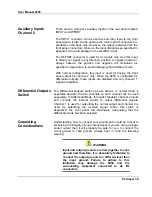
User Manual 9250
2-6 Portrayal
Input/Output Coupling
The default input/output coupling is DC. The 9250 can be ordered AC
coupled. DC coupling is recommended for signals that have dc
components with low frequencies operation. Appendix A specifies the
frequency limitation for inputs/outputs configured to AC coupling.
Single-ended/Differential Outputs
The default configuration is single-ended. With this configuration,
there are two independent channels that amplify signals that are
applied to the channel 1 and 2 inputs. The 9250 can be ordered with
differential outputs; In this case, channel 2 input is disabled and
channel 1 output is amplified and routed differentially to both channels
1 and 2. Channel 1 outputs the normal signal and channel 2 outputs
the inverted phase signal. Appendix A specifies the properties of the
9250 when configured for differential outputs operation.
Field Configuration
of the 9250 Settings
Limited flexibility is available for you, as the user, to change 9250
configuration in the field. Changing configuration involves the opening
of the top cover and therefore, it is suggested that this operation be
completely avoided or, if absolutely necessary, should be carried out
by factory-trained person.
Use the following instructions to re-configure 9250 settings in the field:
Remove the Top Cover
There are four screws bolting the top cover to the case. These are
located on both sides of the cover. Identify and remove these screws.
Use Philips screwdriver only to remove the screws. Hold the cover
from both sides and pull upwards until the top is clear of the case
sides. Once the top cover is open, you’ll be able to access jumpers
that set the different configuration.
Configure the Input Impedance
Before you change the 9250 input impedance settings, identify first
the jumper location for all of the inputs. Figure 2-1 shows an example
of the channel 1 input impedance jumpers. Place the jumpers as
required according to the following table:






























